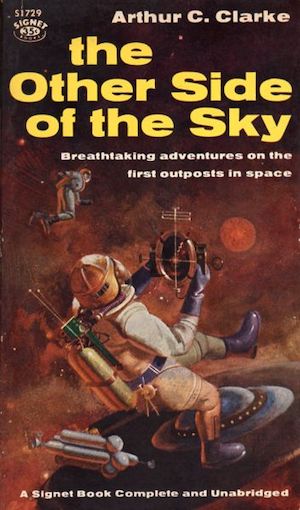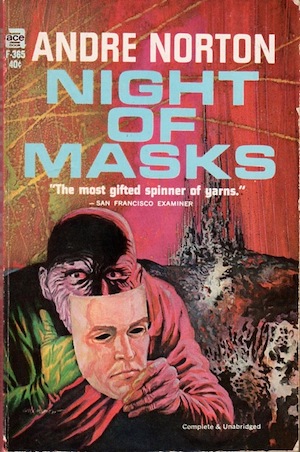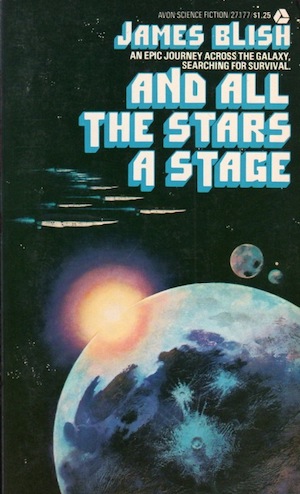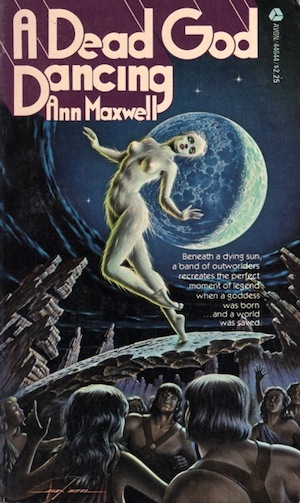Life on Earth is most likely doomed…in a billion years or so. The Sun’s slowly increasing luminosity will trigger a runaway greenhouse effect like that seen on Venus. Later stages in stellar evolution will further sear the Earth into an airless husk (unless the red giant sun simply gobbles up the planet like a piece of candy). Oh woe is us!
The following five tales of dying worlds might be of some interest during this interesting time. Remember: when the prospect of yet another Zoom meeting provokes anxiety and loathing, we can always tell ourselves that it could be worse…
“The Star” by Arthur C. Clarke (1955)

Human starships dispatched to a distant star system discover that the system once harboured life. More than that, it was home to an advanced civilization. Emphasis on “was”; the massive star at the heart of the system has long since gone supernova [1]. Since the aliens had not mastered interstellar starflight, they died with their star. Refusing to be erased entirely, the aliens left a complete record of their history in a secure vault on a world in the outskirts of their doomed system. If not for the vault, humans would have no idea that the aliens had ever existed.
Destroyed by natural forces before they could escape their system, it might seem the aliens lived for naught. The expedition’s astrophysicist fears that the truth might be far worse: that the aliens died for a purpose that horrifies the human scientist.
***
Night of Masks by Andre Norton (1964)

Disfigured in war, relegated to a refugee oubliette known as the Dipple, it’s unlikely that orphan Nik Kolherne will ever escape misfortune through legitimate means. When criminals offer to repair the young man’s face in return for certain illicit services, Nik agrees.
Said services seem innocent enough: pose as fictional hero Hacon. The catch is this is part of a ruse to manipulate naïve kidnap victim Vandy. Nik belatedly regrets his excursion into criminality, but by that time he and Vandy escape from Nik’s employers, Nik and Vandy are on forbidding Dis, a world of perpetual night under an invisible star, left nearly lifeless by an enormous solar flare. Almost lifeless, that is, save for the ravenous monsters hiding in the eternal dark.
***
…And All the Stars a Stage by James Blish (1971)

An exploding star led Jorn Birn’s people to discover the secrets of controlled nuclear fusion. This technology bestowed unparalleled wealth on Jorn’s world…but not on Jorn, who has the bad luck to be male in a world with altogether too many men, men who are thus surplus to requirements. In this world, women rule and it’s a lucky man who finds a woman willing to support him.
A quirk of stellar evolution renders moot an otherwise tediously regrettable example of flipped gender roles: The star around which Jorn’s home world orbits is as doomed as the star that gave his people fusion. If they do nothing, Jorn’s people are doomed as well. When the world is burning, it does not matter who is in charge.
A vast fleet of interstellar ships is hastily assembled, crewed, and launched. The crew, Jorn among them, escape the explosion that consumes their world. It’s just too bad that the fleet doesn’t know where it is going; it was launched in the hope that a second habitable world existed somewhere out in the galaxy. The dwindling fleet checks planet after planet and finds no suitable option. Is the fleet doomed to roam until the ships fail?
***
“Sun Up” by A.A. Jackson IV and Howard Waldrop (1976)

Dispatched by relativistic ramjet, the robot exploration ship Saenger arrives at its red giant destination and discovers that the star is far more interesting than expected. It is only a year away from going supernova. This will be fascinating for the scientists back on Earth, who are receiving superluminal communications from the Saenger. Bully for science! And there is no indigenous life in the system [2], so there’s no need to be sad.
But wait! Saenger isn’t indigenous, but it is sentient in its own right. It doesn’t have the resources it would need to flee the system and there is no time to resupply the ship in the time available. It seems that all the robot can do is wait for certain doom.
This is the first time that an AI will knowingly face death. What will it do? What can it do? Is there a way out of this trap?
***
A Dead God Dancing by Ann Maxwell (1979)

A nearby supernova nearly sterilized Tal-Lith millennia ago. Now its errant home star will finish the job with a massive solar flare. Tal-Lith’s impending doom forces the star-spanning Concord to reconsider its non-interference policy regarding pre-spaceflight cultures like Tal-Lith. A covert contact team is dispatched to prepare the handful of natives for relocation to a new home world.
Tal-Lith is one minor world among many. The Concord does not pay close attention to such worlds. As a consequence, impending doom was discovered at the last moment. Rather than carefully selecting agents who are most suitable for the task, the Concord is forced to use those who are immediately available. The result is a collection of strangers, ill-suited to teamwork…one of whom has their own, incredibly dangerous agenda.
***
No doubt I have overlooked worthy examples. No doubt you are even now reaching for your keyboard. The comment section is waiting for you below.
1: Clarke liked exploding suns enough for the idea to turn up over and over in his work (I could have mentioned “The Songs of Distant Earth” or “Rescue Party” in this essay, but didn’t.) But he also suspected suns of inconveniently dimming; for example, in “Fountains of Paradise” and “History Lesson,” humans face problems caused by stellar cooling. Too bad that stars are fundamentally unreliable.
2: It’s usual for writers to imagine an inhabited world faced with a looming supernova. Cue up the suspense, cue up the drama! But astronomy has no respect for narrative needs. In reality, there are only a few kinds of stars that are prone to supernova-ing and none of them are conducive to terrestrial worlds with complex life. For that matter, supernovas also don’t care about human impatience; the supernova candidate nearest to Earth is due to explode any day now as stars measure time. That’s one hundred thousand years, plus or minus, for you and me. Hat tip to Valerie Valdes’ “Prime Deceptions: A Novel,” which features a doomed star system whose UNAVOIDABLE DEMISE! won’t happen for millennia and is completely irrelevant to the plot.
In the words of Wikipedia editor TexasAndroid, prolific book reviewer and perennial Darwin Award nominee James Davis Nicoll is of “questionable notability.” His work has appeared in Publishers Weekly and Romantic Times as well as on his own websites, James Nicoll Reviews and Young People Read Old SFF (where he is assisted by editor Karen Lofstrom and web person Adrienne L. Travis). He is a four-time finalist for the Best Fan Writer Hugo Award and is surprisingly flammable.











The quintessential dying world book: Tales of the Dying Earth by Jack Vance!
Edgar Ric Burroughs’s A Princess of Mars.
Add to the list, John Campbell’s (as “Don A. Stuart”) “Twilight” and “Night,” Poul Anderon’s “”Day of Burning” (originally titled “Supernova”), and Edmond Hamilton’s “The Inn Outside the World” (which goes past the death of a star to the heat death of the universe).
Doris Lessing: The Making of the Representative of Planet Eight – onset of terminal ice age despite all the powers of the civilised galaxy can do.
Dying of the Light by George R R Martin, long before he was a megastar. Set on a world that was dead, came to life, and is now dying again
Dying of the Light was the cover story for the first Analog I bought in the long long ago. Except it was called After the Festival.
See also Clark Ashton Smith’s “Zothique” series, sixteen stories published in Weird Tales from 1932 to 1953, and later collected in a Ballantine Adult Fantasy volume in 1970.
I re-read “Dying of the Light” recently, and was pleased to see that it lived up to my memories of it. The setting is vivid, and the characters and moral choices involved are satisfyingly complicated. And there’s a melancholy tone that fits well with the setting.
The first and still the most terrifying ‘dying world’ novel that I read was Tove Jansson’s “Comet in Moominland”.
I’m sure the dying planet of Skaith was on your mind, but its OK that it didn’t make the cut this time since you’ve already reviewed Leigh Brackett’s Eric John Stark adventures.
In J. T. McIntosh’s One in Three Hundred (a fixup of the novella of that title and two following works), the Earth is about to be uninhabitable (I forget why), so that fraction of the human race is to be removed to Mars, with all the kinds of disruption you might expect in a book from the 1950’s. I don’t recommend this book — there’s at least one point that will revolt most of the people it doesn’t trigger — but it’s an example. (Several years ago, his World Out of Mind was cited at Eastercon as a lost classic, which is true only if you consider “classic” to mean “a specimen of its time”.)
Spoiler: In Asimov’s The Currents of Space all the hoo-hah turns out to be caused by economic & political interests trying to hide the discovery that a valuable planet is about to be scorched by its star. Another 1950’s work that probably doesn’t read well today, but not as actively repulsive.
“Fountains of Paradise” … humans face problems caused by stellar cooling
Although by the time stelllar cooling comes into play in “Fountains” (in the epilogue set in the far future), humans are technologically advanced enough that the cooling is a fairly trivial problem at most.
Every one of these books is a must!
This weeks Bundle of Holding has a bunch of Smith books:
https://bundleofholding.com/presents/NightShadeWeird
Not a book, but a memorable episode of Night Gallery, with the misleading title of ‘The Boy Who Predicted Earthquakes’.
“The Last Question” by Asimov ends just after the End of (almost) Everything in the universe.
@11: We already have the technology to cater for small decreases in solar luminosity – pumping CO2 or other greenhouse gases into the atmosphere. Otherwise a big mirror at the earth-sun L3 point, which might give better temporal fine control. I’m almost certain that it gives better spatial fine control – the greenhouse gas solution changes preferentially warms the arctic regions.
Michael Moorcock’s series “The Dancers at the End of Time” is set on Earth far in the future, when the universe is coming to an end, full stop. It’s a setup for some of Moorcock’s funniest writing, but the subject is still serious.
Of course there is The Time Machine.
A Nicoll-Dyson laser can decisively solve global cooling at intergalactic distances.
https://en.wikipedia.org/wiki/James_Nicoll#Nicoll-Dyson_Laser
I reviewed that one! The sun is going to get just a bit brighter. No biggie on a cosmic scale but enough to kill everything on Earth.
Protagonist Easson, whose job it is to select which one in three hundred from some backwater town will live, has a rather sunny optimism concerning the process of picking who lives and who dies.
Another view is that bigots handed the power of life and death are going to be doing handsprings in glee over the chance of transforming prejudice into policy. Poor Pat might be a good example: she has no remarkable flaws and arguably as many virtues as anyone in town but because she’s promiscuous, absolutely nobody expects her to be saved.
The story does take a remarkable view of who to save:
Easson at least isn’t making any attempt to select an elite. He considers the idea of even trying absurd and misguided.
What an unusual perspective in a 1950s lifeboat story!
J. T. McIntosh’s Born Leader (aka Worlds Apart), yet ANOTHER book that posits a dying Earth (in this case due to the effects of nuclear power) that sends “arks” to another planet to save civilization. In this case, McIntosh’s posited solution to the problem of racial prejudice in selection of who will be saved was simpler — the world got together, and decided that if people of different races were on the same ships, there would be issues. So the noble black and Asian people decided, VOLUNTARILY, we are told, that they would sacrifice themselves and accede to a policy that only white people would be accepted for the arks. That was one of the more jaw-dropping paragraphs I’ve read in my explorations of ’50s SF!
My first Analog was a bit earlier than yours — it was a couple of issues after Martin’s first “big” story, “A Song for Lya”, and the serial was Tak Hallus’ Stargate. But I do remember After the Festival, yes. (I’ve only read the serial, so I don’t know if Dying of the Light was expanded or otherwise altered.)
And surely if we are talking about “Dying Worlds” we should mention The Book of the New Sun!
William Hope Hodgson’s The Night Land, set in the far future when the sun has burned out and the last remnants of humanity live in a single colossal structure, sheltered from the terrors of the night land around them.
Shame that it’s pretty much unreadable due to Hodgson’s very, very bad faux-medieval pose. James Stoddard did a “translation” of it into less flowery language that was at least a lot more accessible.
@17: Especially when Elric shows up.
@3, Speaking of Edmund Hamilton, don’t forget his ‘City at World’s End’ or Arthur C. Clarks’ Against the Fall of Night/The City and the Stars, basically two versions of a dying galaxy story.
21: That sounds a lot like a modern text that made the news a while back, which explained to school kids that the indigenous peoples of North America decided to step aside so the newcomers would have room to settle.
You mentioned Golden Witchbreed yesterday, and you could have mentioned Ancient Light today.
And Greg Bear’s City at the End of Time, set impossibly far in the future when the universe itself is kind of winding down; and didn’t Stephen Baxter’s Xeelee books have suns being artificially extinguished on a massive scale?
@21, @25,
Or the AP US History text that referred to slaves as “immigrants,” in the same context as was used for people from northern Europe? The one which implied they came voluntarily?
One would think that a textbook publisher could tell the difference between history and propaganda.
—–
Back on the topic of dying worlds! (It’s so much less likely to get teeth punched out.)
Jack Williamson, Terraforming Earth.
—-, Humanoids.
Stephen Baxter, Proxima (well, it is dying due to a terminal case of human stupidity. One can never accuse Baxter of being particularly optimistic)
One would think that a textbook publisher could tell the difference between history and propaganda.
One would like to think so…
What, no “When Worlds Collide” ?
https://www.amazon.com/Worlds-Collide-Bison-Frontiers-Imagination/dp/0803298145/
So good it was made into a movie also.
https://www.amazon.com/When-Worlds-Collide-Richard-Derr/dp/B08BHR6LC8/
The Songs Of Distant Earth by Arthur C. Clarke features a humanity that has centuries to prepare for a supernova. While the plot of the novel is very slight it does feature some amazing sequences about potential futures and some (possibly horrifying) sociological choices made when establishing new colonies.
Judith Tarr’s Forgotten Suns.
Well of Shiuan by C.J. Cherryh
Pretty much every planetary romance book set on Mars fits this bill. Is this a sign that SF writers move in herds?
A more recent take on the subject comes from an excellent audio drama called The Sojourn, it’s produced by the same people who do the Spacedock YouTube channel. It’s a space opera centered around the Avalon Expedition, a desperate attempt by the inhabitants of a remote star cluster to find new resources to sustain their dying planets, and it’s really interesting stuff.
The world of Charn in The Magician’s Nephew.
Argo City, where Supergirl came from in her original comics, which somehow survived the explosion of Krypton but was doomed to a slow death as the bedrock gradually transmuted to Kryptonite.
My favorite end of the world story is in Judith Merril’s 6th Best of anthology: “The Carson Effect”, by Richard Wilson. I don’t know how widely it was reprinted, but it’s awfully good and you should look it up.
(While trying to figure out which one it was in–the one that changed my life was the 7th–I ran into a well-written Amazon review that completely missed the point of the series:
The more things change…)
Inconstant Moon by Larry Niven should get an honorable mention in the short story category.
So, years ago DC Comics published Annual issues, these were out-of-continuity single-issue stories published in addition to their monthly books. Back in the 90s, the Annuals used to be themed, with every Annual that year all based on the same concept.
In 1996, that was “Legends of the Dead Earth,” stories set thousands, millions, or even billions of years after Earth itself had died, at a point when the iconic DC heroes had become nothing more than half-forgotten legends and myths. It ended up being surprisingly uplifting; while Earth and its people were long gone, there will always be heroes.
Sadly, they don’t appear to have been collected anywhere, so anyone who wants to read them will have to track down individual issues.
William Hope Hodgson’s The Night Land is a classic dying earth tale. Lots of people complain about the ornate style but if you approach it like a historical text it’s fine. The story is strong and strange enough to compensate.
A quick scientific interjection. The 1 billion year figure actually contains quite a bit of uncertainty, because we do not know the exact chemical composition of the solar core. (I haven’t been to the solar core, have you?)
However, a few months ago the first detection of solar CNO neutrinos was announced, so in the future we may be able to constrain the rate of the CNO cycle (compared to hydrogen burning) and greatly improve our prediction for the sun’s future evolution.
‘Nifft the Lean’ has a very ‘dying earth’ vibe about it, especially the last story.
This book is a classic. I can’t believe it (or the sequels) haven’t been reissued. Or that they’re not available on kindle.
@36- Dead and dying, no less, in that the population has been wiped out millennia ago and now entropy is winding down the rest of the system, as I recall.
@45 — Yes, Michael Shea was taken from us entirely too soon.
In terms of fantasy stories about dead or dying worlds, two that spring to mind are Michael Reaves’ Shattered World/Burning Realm and Weis/Hickman’s Death Gate Cycle.
@45 Centipede Press is preparing a reissue that’s supposed to be released soon (probably around Christmas) Since this is Centipede Press, though, be warned it’s going to be a limited deluxe edition of great quality and, as such, TERRIBLY EXPENSIVE.
@45 — Nifft the Lean is a successor of sorts to The Quest for Simbilis, which was a Vance-authorized Dying Earth sequel. I can’t remember if Nifft the Lean is still officially in the same world, or if Shea filed off the serial numbers when writing it. (Not intended in any disparaging way — Nifft is most assuredly an original Shea creation.)
@29,
Worse is if they know and publish propaganda anyhow.
—–
Another, this by Robert Silverberg: Hot Sky at Midnight. I remember reading this, and not particularly liking it. I usually like Silverberg’s novels, but this one just didn’t do it for me.
Someone mentioned Asimov’s “The Last Question.” If you ask Alexa or Siri “Can entropy be reversed” you get a fun answer
Okay, I wanted to see if I could find a new title to add to this discussion, and was disappointed to find that the first few that came to mind were already taken. C. J. Cherryh, Leigh Brackett, Jack Vance, and everybody who did the Dying Mars trope.
Nobody mentioned, however, Jack Williamson’s The Black Sun, published in ’97. The plot: An experimental quantum-wave drive is perfected, and a group of people sent out on a ship. The ship will re-materialize at some point at some time (possibly in the distant future) if it hits the right conditions, or it might simply go on forever, never stopping. The occupants of the ship find themselves at a dying planet around a dead (or nearly-dead) star. Not great, but for my money passable as a paperback.
A better (for my money) example was S. M. Stirling’s In the Courts of the Crimson Kings, which was a good example of a Dying Mars book that was quite different than most, more realistically gritty than Brackett’s Mars or C. L. Moore’s.
Feersum Endjinn by Iain M Banks. I guess also the Vavatch Orbital.
Deep Six by Jack McDevitt.
Night of Masks took me on a journey just with the blurb alone XD
The Star was amazing (I’m not sure if the audiobook I listened to was abridged or if it is just a shorter story?)
These all sound extremely readable tbh!
Here’s an online copy of Clarke’s classic “The Star”
https://sites.uni.edu/morgans/astro/course/TheStar.pdf
Re: forgetting you’ve reviewed stuff. Well, “me too.”
As always, thanks for your reviews & recos!
Another 1950’s book that probably won’t get a mention is Neville Shute’s “On The Beach”. Basically the aftermath of WW3 i.e. the end of the world due to nuclear war, and no way of getting off the planet. A very good read.
Don’t forget Nightwings by SIlverberg!
How about Fritz Leiber’s A Pail of Air?
Mark Lawrence’s Red Sister has a cooling planet with a population that has forgotten spaceflight living in a narrow ribbon of green between glaciers that is kept warm by a slowly de-orbiting space mirror.
Octavia Butler’s Lilith’s Brood. While the dying Earth isn’t front and center, it is the backdrop.
Fernhunter@60: That’s an awesome suggestion! “A Pail of Air” is Leiber at his best.
Another short story that took a while to surface is Robert Silverberg’s “When We Went to See the End of the World”. That one kills me every time. There’s at least one other “dead earth” story in the Unfamiliar Territory paperback, but this one’s the best.
ETA: Ooh! There’s a podcast of it! Rated R. Contains drugs, swinging, and frequent gratuitous apocalypses. I can’t wait.
At Milliways the End of the Universe is the floor show. Try to ignore the depressed robot parking valet.